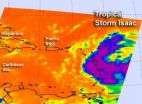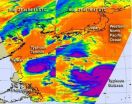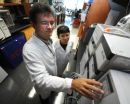(Press-News.org) A mother's emotional health and education level during her child's earliest years influence oral health at age 14, according to a new study from Case Western Reserve University's School of Dental Medicine.
Researchers started with the oral health of the teens and worked backwards to age 3 to find out what factors in their past influenced their oral health outcomes.
While mothers were interviewed, lead investigator Suchitra Nelson, professor in the dental school, believes it can apply to whoever is the child's primary caregiver.
Nelson's team examined the teeth of 224 adolescent participants in a longitudinal study that followed very low birth weight and normal birth weight children. Over the years, researchers gathered health and medical information from the children and their mothers to assess the child's wellbeing at age 3, 8 and now 14.
The researchers analyzed the teen's oral health by counting the number of decayed, filled or missing permanent teeth and assessed the level of dental plaque, a symptom for poor oral hygiene.
Mothers completed a questionnaire about preventative treatments from sealants to mouthwashes, sugary juice or soft drink consumption and access to dental care and frequency of dental visits.
The data revealed that even with access to dental insurance, fluoride treatments and sealants as young children, it did not always prevent cavities by the age of 14, said Nelson, professor of community dentistry at Case Western Reserve dental school.
She is lead investigator on the Journal of Dental Research article, "Early Maternal Psychosocial Factors are Predictors for Adolescent Caries."
What did prevent cavities in teens?
Using a statistical modeling program that tracked pathways from the teen's dental assessments back to the source of where the oral health originated led researchers right to mothers and their overall emotional health, education level and knowledge when children were at ages 3 and 8.
The researchers found if mothers struggled in any of the three areas, the oral health of the teens at age 14 resulted in higher numbers of oral health problems.
"We can't ignore the environments of these children," Nelson said. "It isn't enough to tell children to brush and floss, they need more—and particularly from their caregivers."
The oral health boost comes from mothers, who muster coping skills to handle everyday stresses and develop social networks to provide for their children's needs.
It was found that mothers with more education beyond high school, with healthy emotional states and knowledge about eating right had children with healthier teeth.
"We cannot ignore these environmental influences and need interventions to help some moms get on track early in their children's lives," Nelson concludes.
Nelson says moms need to care for themselves to help their children. She likens it to the emergency instructions on an airplane that mothers put on the mask first and then their children. "How can a mother help her child if she passes out," asks Nelson. "It's all common sense, but some mothers may need help."
###Contributing to this study were Wonik Lee, research associate, and Jeffrey. M. Albert, associate professor from the Department of Epidemiology and Biostatistics and Lynn Singer, Deputy Provost and Vice President of Academic Affairs and professor in the Department of General Medicine and Pediatrics at the Case Western Reserve School of Medicine.
Support for the study came from National Institute of Health's Institute of Dental and Craniofacial Research and the Health Resources and Services Administration's Maternal and Child Health Program.
Moms linked to teen oral health, says CWRU dental study
2012-08-23
ELSE PRESS RELEASES FROM THIS DATE:
Super-strong, high-tech material found to be toxic to aquatic animals
2012-08-23
Carbon nanotubes (CNTs) are some of the strongest materials on Earth and are used to strengthen composite materials, such as those used in high-performance tennis rackets. CNTs have potential uses in everything from medicine to electronics to construction. However, CNTs are not without risks. A joint study by the University of Missouri and United States Geological Survey found that they can be toxic to aquatic animals. The researchers urge that care be taken to prevent the release of CNTs into the environment as the materials enter mass production.
"The great promise ...
Nematodes with pest-fighting potential identified
2012-08-23
This press release is available in Spanish.
Formosan subterranean termites could be in for a real headache. U.S. Department of Agriculture (USDA) scientists have identified species of roundworms, or "nematodes," that invade the termite brains and offer a potential bio-based approach to controlling them. Other nematodes that were identified invaded tarantula brains.
The Formosan termite, a nonnative species from Asia, feeds on cellulose from the heartwood of trees, the wood support beams of buildings, and other sources. It causes an estimated $1 billion annually in ...
Cramming for a test? Don't do it, say UCLA researchers
2012-08-23
Every high school kid has done it: putting off studying for that exam until the last minute, then pulling a caffeine-fueled all-nighter in an attempt to cram as much information into their heads as they can.
Now, new research at UCLA says don't bother.
The problem is the trade-off between study and sleep. Studying, of course, is a key contributor to academic achievement, but what students may fail to appreciate is that adequate sleep is also important for academics, researchers say.
In the study, UCLA professor of psychiatry Andrew J. Fuligni, UCLA graduate ...
NASA sees Tropical Storm Isaac and Tropical Depression 10 racing in Atlantic
2012-08-23
VIDEO:
This animation of satellite observations from August 19-22, 2012, shows the development and movement of Tropical Storm Isaac toward the Lesser Antilles. This visualization was created by the NASA GOES...
Click here for more information.
There are now two active tropical cyclones in the Atlantic and NASA is generating satellite imagery to monitor their march westward. Tropical Storm Issac is already bringing rainfall to the Lesser Antilles today, Aug. 22, Tropical ...
University of Colorado analysis of election factors points to Romney win
2012-08-23
A University of Colorado analysis of state-by-state factors leading to the Electoral College selection of every U.S. president since 1980 forecasts that the 2012 winner will be Mitt Romney.
The key is the economy, say political science professors Kenneth Bickers of CU-Boulder and Michael Berry of CU Denver. Their prediction model stresses economic data from the 50 states and the District of Columbia, including both state and national unemployment figures as well as changes in real per capita income, among other factors.
"Based on our forecasting model, it becomes clear ...
Double trouble continues in the Philippine Sea: Tembin and Bolaven
2012-08-23
Typhoon Tembin and Typhoon Bolaven continue to churn in the Philippine Sea, and infrared satellite data from NASA showed the power within both storms.
The Atmospheric Infrared Sounder (AIRS) instrument that flies onboard NASA's Aqua satellite captured imagery of both storms on Aug. 21 in two different overpasses. Aqua flies over the same locations during early morning and early afternoon (local time) as it orbits the Earth. Aqua passed over the Philippine Sea on Aug. 21 at 04:41 UTC (12:41 a.m. EDT) and 16:47 UTC (12:47 p.m. EDT). The two satellite passes were combined ...
Scientists from UCLA, Israel's Technion uncover brain's code for pronouncing vowels
2012-08-23
Scientists at UCLA and the Technion, Israel's Institute of Technology, have unraveled how our brain cells encode the pronunciation of individual vowels in speech.
Published in the Aug. 21 edition of the journal Nature Communications, the discovery could lead to new technology that verbalizes the unspoken words of people paralyzed by injury or disease.
"We know that brain cells fire in a predictable way before we move our bodies," said Dr. Itzhak Fried, a professor of neurosurgery at the David Geffen School of Medicine at UCLA. "We hypothesized that neurons would ...
Video shows the traffic inside a brain cell
2012-08-23
Using bioluminescent proteins from a jellyfish, a team of scientists has lit up the inside of a neuron, capturing spectacular video footage that shows the movement of proteins throughout the cell.
The video offers a rare peek at how proteins, the brain's building blocks, are directed through neurons to renew its structure. It can be viewed online here: http://www.youtube.com/watch?v=baI9q2--q7s&feature=youtu.be
"Your brain is being disassembled and reassembled every day," said Don Arnold, associate professor of molecular and computational biology at the USC Dornsife ...
ORNL researchers probe invisible vacancies in fuel cell materials
2012-08-23
Knowing the position of missing oxygen atoms could be the key to cheaper solid oxide fuel cells with longer lifetimes. New microscopy research from the Department of Energy's Oak Ridge National Laboratory is enabling scientists to map these vacancies at an atomic scale.
Although fuel cells hold promise as an efficient energy conversion technology, they have yet to reach mainstream markets because of their high price tag and limited lifespans. Overcoming these barriers requires a fundamental understanding of fuel cells, which produce electricity through a chemical reaction ...
Targeting inflammation to prevent, treat cancers
2012-08-23
Augusta, GA—Researchers at the Georgia Health Sciences University Cancer Center have identified a gene that disrupts the inflammatory process implicated in liver cancer.
Laboratory mice bred without the gene lacked a pro-inflammatory protein called TREM-1 and protected them from developing liver cancer after exposure to carcinogens.
The study, published in Cancer Research, a journal for the American Association for Cancer Research, could lead to drug therapies to target TREM-1, said Dr. Anatolij Horuzsko, an immunologist at the GHSU Cancer Center and principal investigator ...


